Abstract
High virus counts were found in water samples collected from the Chesapeake Bay. Viruses were enumerated by ultracentrifugation of water samples onto grids which were visualized by transmission electron microscopy. Virus counts in September 1990, April 1991, June 1991, August 1991, and October 1991 ranged between 2.6 x 10(6) and 1.4 x 10(8) viruses ml-1 with a mean of 2.5 x 10(7) viruses ml-1. Virus counts were usually at least three times higher than direct bacterial counts in corresponding samples. Virus counts in August and October were significantly higher than at the other sampling times, whereas bacterial counts were significantly lower at that time, yielding mean virus-to-bacterium ratios of 12.6 and 25.6, respectively. From analysis of morphology of the virus particles, it is concluded that a large proportion of the viruses are bacteriophages. The high virus counts obtained in this study suggest that viruses may be an important factor affecting bacterial populations in the Chesapeake Bay, with implications for gene transfer in natural aquatic bacterial populations and release of genetically engineered microorganisms to estuarine and coastal environments.
Full text
PDF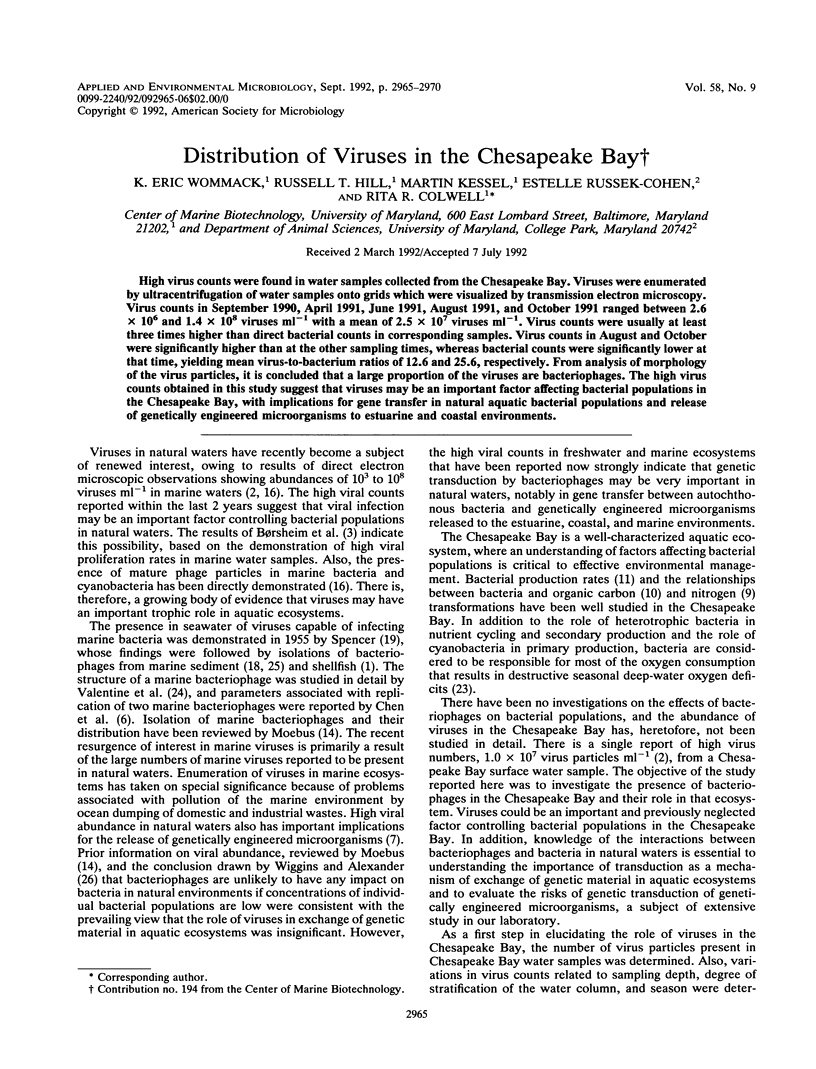
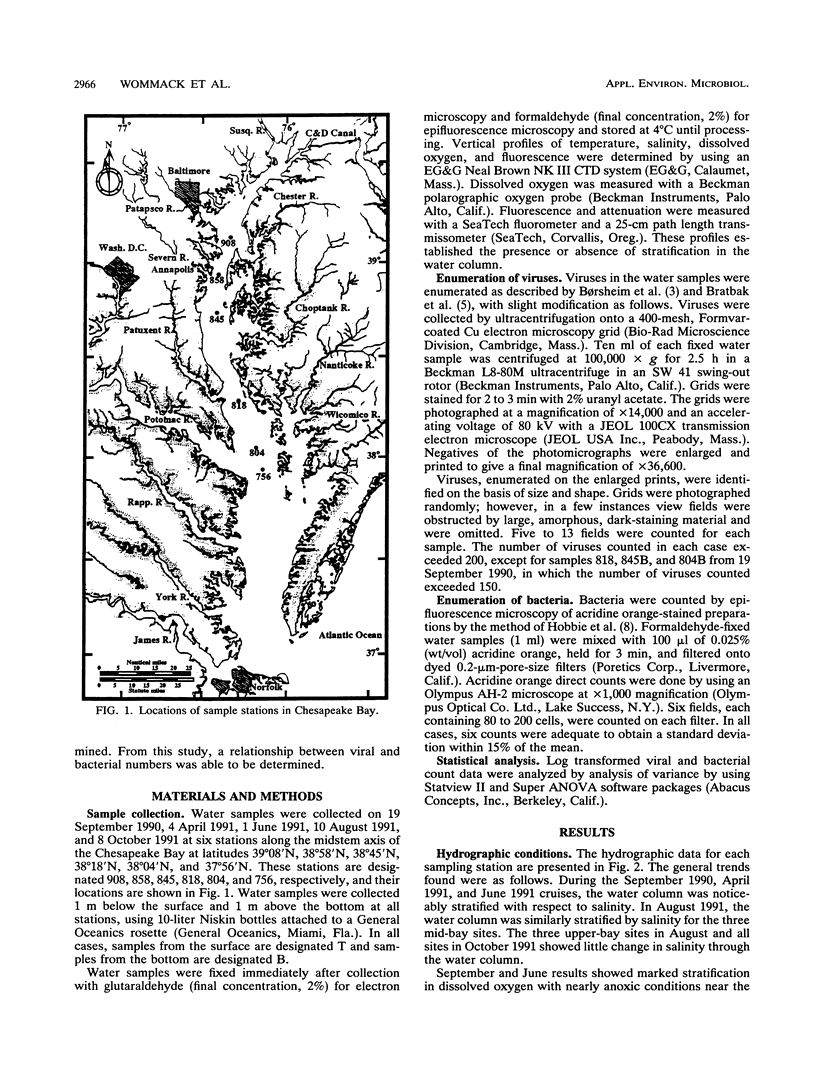
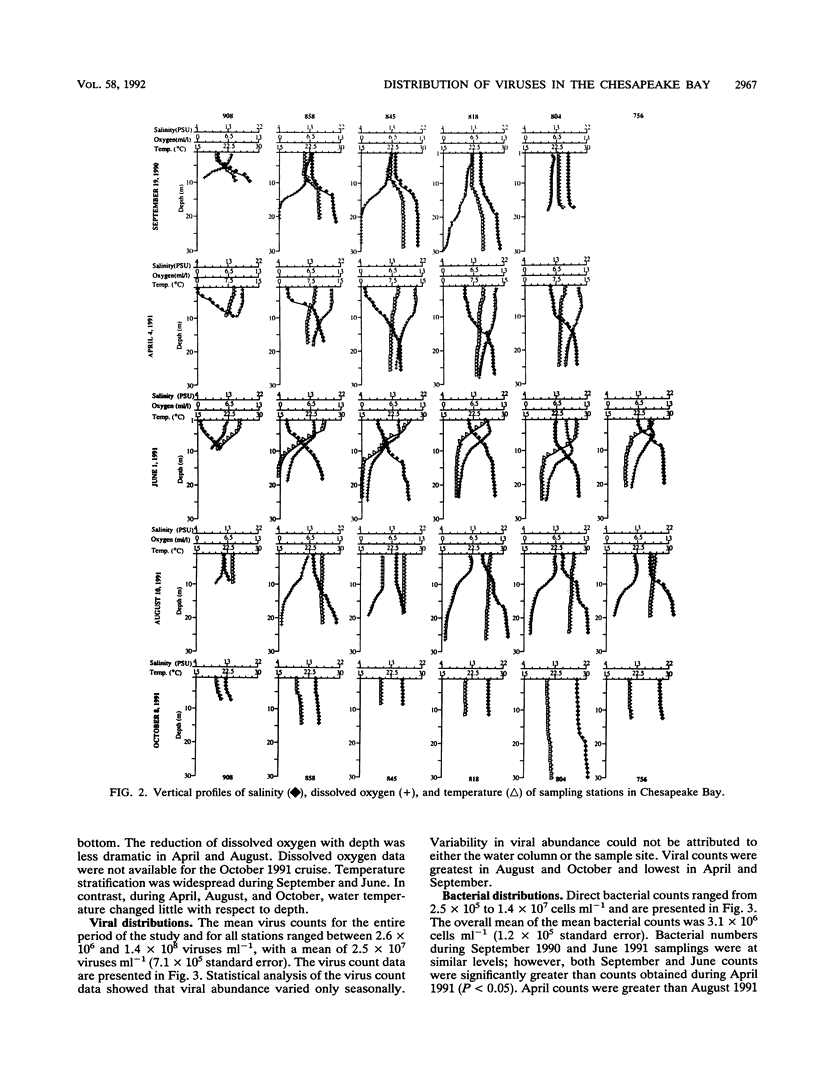
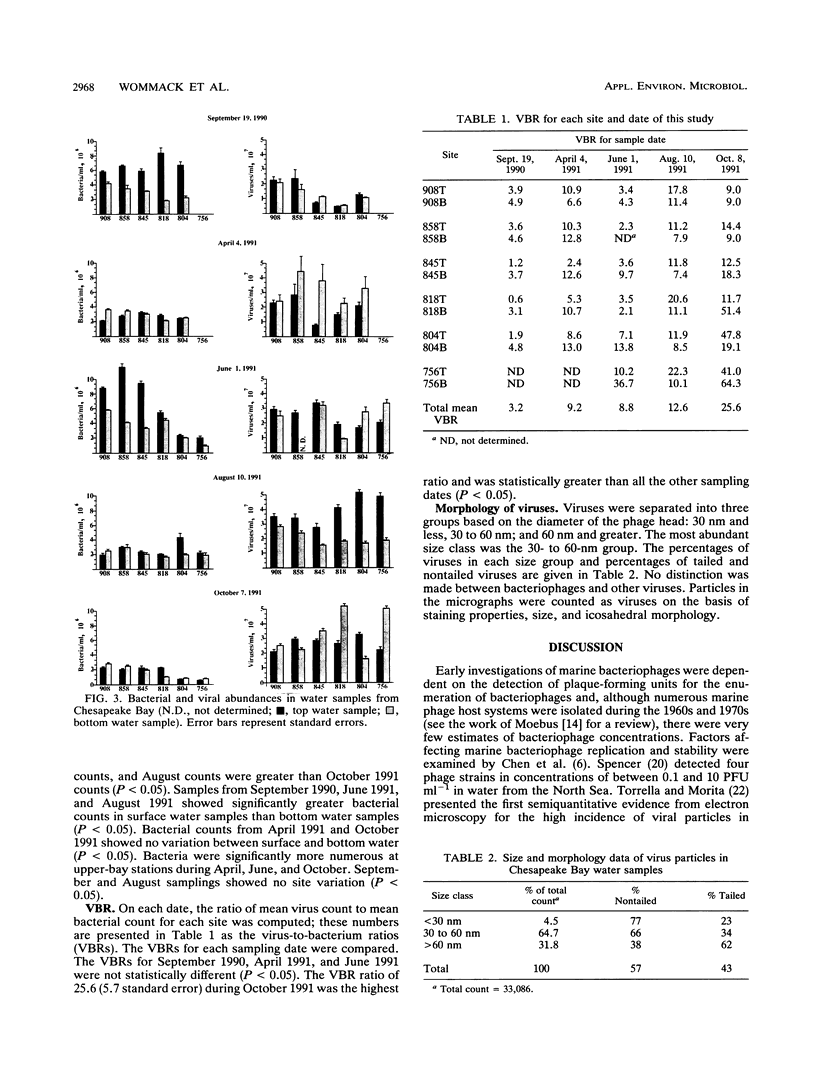

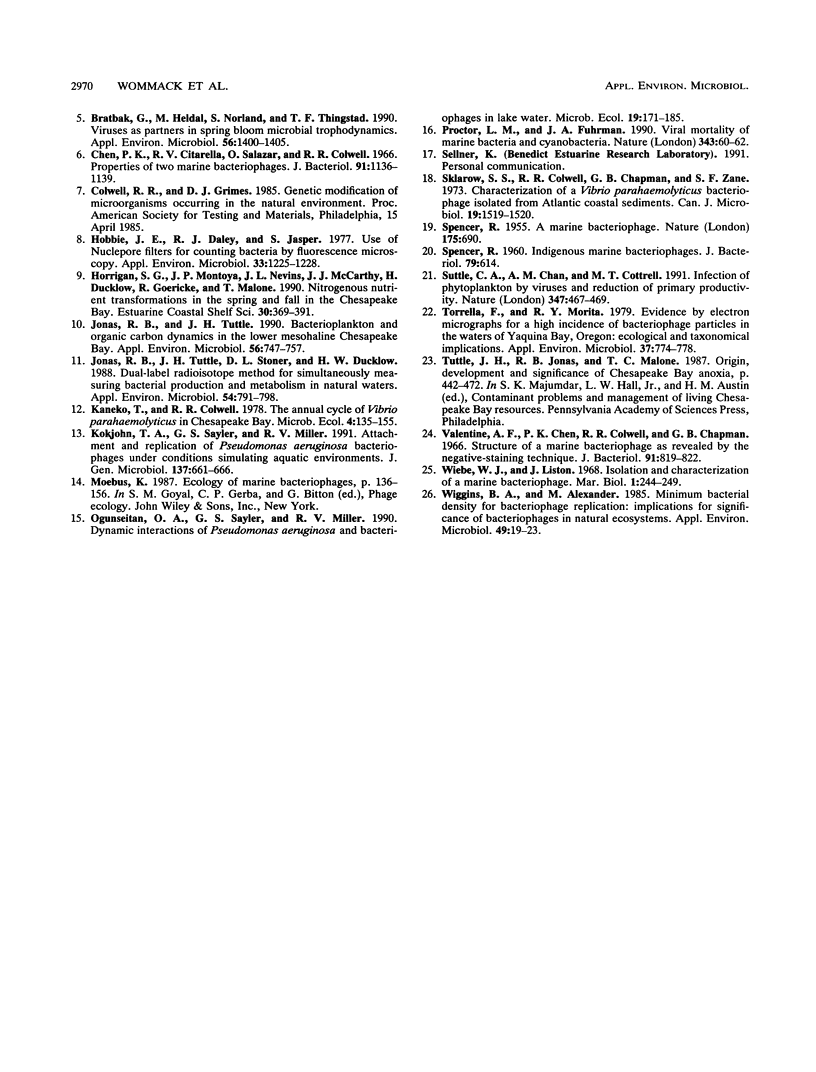
Selected References
These references are in PubMed. This may not be the complete list of references from this article.
- Baross J. A., Liston J., Morita R. Y. Incidence of Vibrio parahaemolyticus bacteriophages and other Vibrio bacteriophages in marine samples. Appl Environ Microbiol. 1978 Sep;36(3):492–499. doi: 10.1128/aem.36.3.492-499.1978. [DOI] [PMC free article] [PubMed] [Google Scholar]
- Bergh O., Børsheim K. Y., Bratbak G., Heldal M. High abundance of viruses found in aquatic environments. Nature. 1989 Aug 10;340(6233):467–468. doi: 10.1038/340467a0. [DOI] [PubMed] [Google Scholar]
- Bradley D. E. Ultrastructure of bacteriophage and bacteriocins. Bacteriol Rev. 1967 Dec;31(4):230–314. doi: 10.1128/br.31.4.230-314.1967. [DOI] [PMC free article] [PubMed] [Google Scholar]
- Bratbak G., Heldal M., Norland S., Thingstad T. F. Viruses as partners in spring bloom microbial trophodynamics. Appl Environ Microbiol. 1990 May;56(5):1400–1405. doi: 10.1128/aem.56.5.1400-1405.1990. [DOI] [PMC free article] [PubMed] [Google Scholar]
- Børsheim K. Y., Bratbak G., Heldal M. Enumeration and biomass estimation of planktonic bacteria and viruses by transmission electron microscopy. Appl Environ Microbiol. 1990 Feb;56(2):352–356. doi: 10.1128/aem.56.2.352-356.1990. [DOI] [PMC free article] [PubMed] [Google Scholar]
- Chen P. K., Citarella R. V., Salazar O., Colwell R. R. Properties of two marine bacteriophages. J Bacteriol. 1966 Mar;91(3):1136–1139. doi: 10.1128/jb.91.3.1136-1139.1966. [DOI] [PMC free article] [PubMed] [Google Scholar]
- Hobbie J. E., Daley R. J., Jasper S. Use of nuclepore filters for counting bacteria by fluorescence microscopy. Appl Environ Microbiol. 1977 May;33(5):1225–1228. doi: 10.1128/aem.33.5.1225-1228.1977. [DOI] [PMC free article] [PubMed] [Google Scholar]
- Jonas R. B., Tuttle J. H. Bacterioplankton and organic carbon dynamics in the lower mesohaline chesapeake bay. Appl Environ Microbiol. 1990 Mar;56(3):747–757. doi: 10.1128/aem.56.3.747-757.1990. [DOI] [PMC free article] [PubMed] [Google Scholar]
- Jonas Robert B., Tuttle Jon H., Stoner Daphne L., Ducklow Hugh W. Dual-Label Radioisotope Method for Simultaneously Measuring Bacterial Production and Metabolism in Natural Waters. Appl Environ Microbiol. 1988 Mar;54(3):791–798. doi: 10.1128/aem.54.3.791-798.1988. [DOI] [PMC free article] [PubMed] [Google Scholar]
- McEuen S. F., Miller M. G. Metabolism and pharmacokinetics of 1,3-dinitrobenzene in the rat and the hamster. Drug Metab Dispos. 1991 May-Jun;19(3):661–666. [PubMed] [Google Scholar]
- SPENCER R. A marine bacteriophage. Nature. 1955 Apr 16;175(4459):690–691. doi: 10.1038/175690a0. [DOI] [PubMed] [Google Scholar]
- Sklarow S. S., Colwell R. R., Chapman G. B., Zane S. F. Characteristics of a Vibrio parahaemolyticus bacteriophage isolated from Atlantic coast sediment. Can J Microbiol. 1973 Dec;19(12):1519–1520. doi: 10.1139/m73-248. [DOI] [PubMed] [Google Scholar]
- Spencer R. INDIGENOUS MARINE BACTERIOPHAGES. J Bacteriol. 1960 Apr;79(4):614–614. doi: 10.1128/jb.79.4.614-614.1960. [DOI] [PMC free article] [PubMed] [Google Scholar]
- Torrella F., Morita R. Y. Evidence by electron micrographs for a high incidence of bacteriophage particles in the waters of Yaquina Bay, oregon: ecological and taxonomical implications. Appl Environ Microbiol. 1979 Apr;37(4):774–778. doi: 10.1128/aem.37.4.774-778.1979. [DOI] [PMC free article] [PubMed] [Google Scholar]
- Valentine A. F., Chen P. K., Colwell R. R., Chapman G. B. Structure of a marine bacteriophage as revealed by the negative-staining technique. J Bacteriol. 1966 Feb;91(2):819–822. doi: 10.1128/jb.91.2.819-822.1966. [DOI] [PMC free article] [PubMed] [Google Scholar]
- Wiggins B. A., Alexander M. Minimum bacterial density for bacteriophage replication: implications for significance of bacteriophages in natural ecosystems. Appl Environ Microbiol. 1985 Jan;49(1):19–23. doi: 10.1128/aem.49.1.19-23.1985. [DOI] [PMC free article] [PubMed] [Google Scholar]


